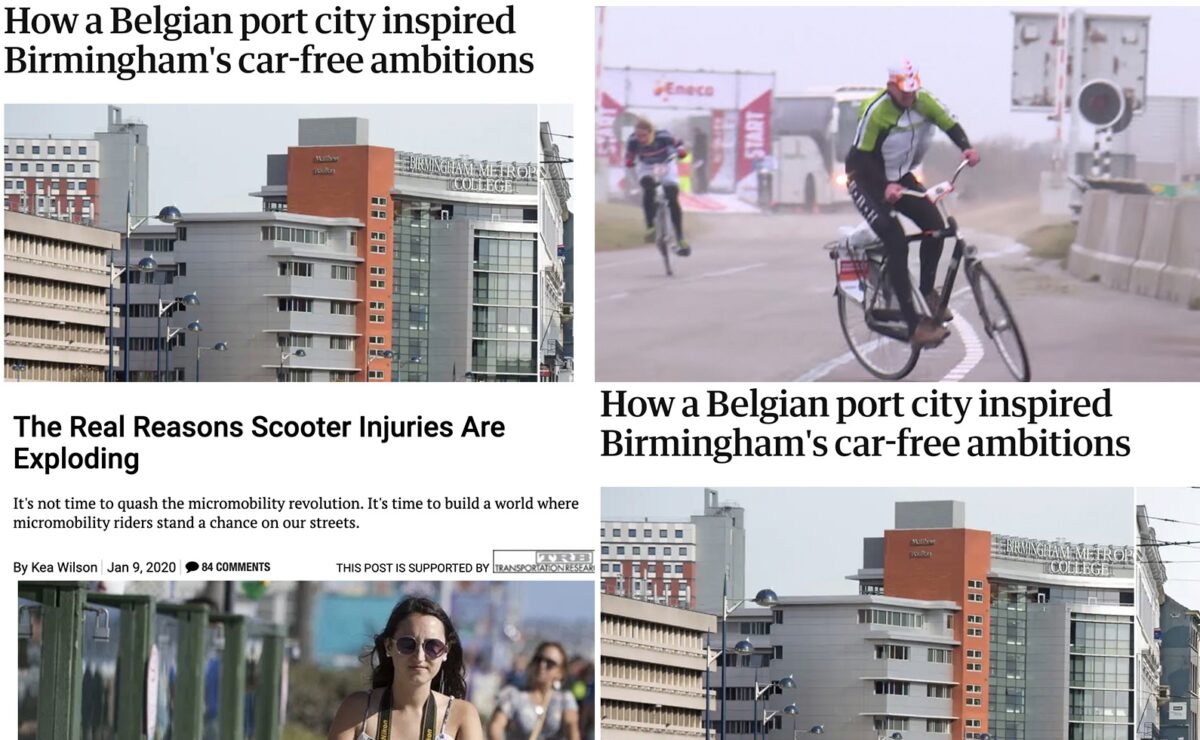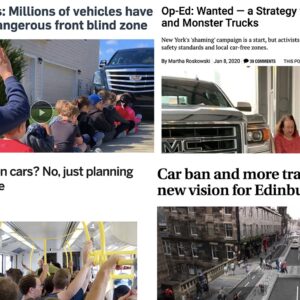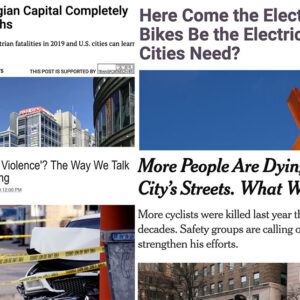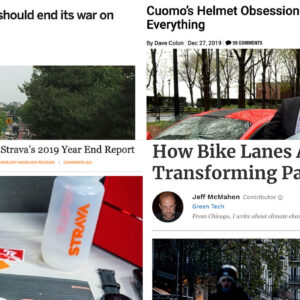Welcome to the week. Here are the most noteworthy items we came across in the past eight days…
Break the addiction: Another week, another city (Birmingham, England) claims its future will be brighter because of a strong plan to limit the use of cars.
Fast buses: Here’s how well bus express lanes — like the ones Commissioner Eudaly wants to create here in Portland — are working in Los Angeles.
The cost of car use: When transportation costs are factored in, a new report found that sprawling, car-centric Houston, Texas is more expensive to live in than New York City.
Just build it: The Oregonian Editorial Board is one of the very few bastions of support that ODOT still has for their plan to add lanes to I-5 through the Rose Quarter.
12,000 people, no cars: Escape into this description of a new community being planned in Utrecht that will have 6,000 dwelling units and will allow residents to, “move freely without their own car.”
Electric cars won’t save us: Here’s even more evidence that the problem is cars — whether they run on batteries or gas (or both).
Pro gravel: Not a big surprise to those who follow gravel riding; but it’s worth noting that the discipline is attracting new money, new teams, and major professionals.
Austin’s big plans: Portland is often compared to the capitol of Texas, so it’s interesting to see what they’re planning for the future of their transit system.
Advertisement
The Paris way: Forget Amsterdam or Copenhagen, the City of Light’s meteoric rise as a cycling city offers many lessons for American cities to learn from (such as, go big or go home).
Transport politics: Been wondering where 2020 presidential candidates stand on transportation? Here’s a roundup.
Global toll: The Economist paints a grim picture, but also offers ways to help, in a piece on road safety around the world.
About that plastic bag: If you order bike apparel online, you’ve seen those “polybags” many items come packed in. Here’s why the outdoor industry uses so many of them and what’s being done to end the practice.
Scooter injury blame: Streetsblog provides a counterpoint to all those hysterical headlines about the rising number of injuries to scooter riders.
Blind biker (video): Learn about a man who became blind at the age of 14 and learned how to mountain bike by using echolocation (similar to a bat).
Video of the Week: Behold the Dutch Headwind Cycling Championships (listen with sound on to hear the laughs!)…
— Jonathan Maus: (503) 706-8804, @jonathan_maus on Twitter and jonathan@bikeportland.org
— Get our headlines delivered to your inbox.
— Support this independent community media outlet with a one-time contribution or monthly subscription.







Thanks for reading.
BikePortland has served this community with independent community journalism since 2005. We rely on subscriptions from readers like you to survive. Your financial support is vital in keeping this valuable resource alive and well.
Please subscribe today to strengthen and expand our work.
Great roundup, but can we please stop calling visually pleasing media ‘porn’? Porn is an abusive, commercial, misogynistic industry and I’m personally sick of it being used in clickbaity headlines.
I hate it too. Sounds cheap and lazy. And for people who get excited by bus lanes, I feel sorry for you.
Yes I’ll stop using that. I actually paused before doing so, but then thought it would be OK. (FWIW I’m not using it to be clickbaity.) Thanks for the feedback.
Yikes, wait until you find out about gold…
If people are worked up about Poly bags…are you worked up about your favorite cliff bar/oatbar/RX bar/(insert favorite snack here)? You aren’t, I know you aren’t. If we actually burned our waste vs. dumping it in the ground, we wouldn’t stress about it.
Yeah, the problem with things like incinerating garbage (including “recyclables”) is that the Green (note this useage is a noun, not an adjective) Movement doesn’t want to know about environmental impact studies that scientifically demonstrate (and are subject to peer review) that incinerating garbage and nuclear fission to generate electrical energy and district heating have much lower environmental impacts that many of the Green Movement’s preferred options. Right now, any benefit we get from recycling is more than offset by the fact that we ship it to recycling plants in Asia or Africa using container ships burning barely enriched crude oil.
Bicycling, even on electric pedal assist bikes, is better for the environment as long as you keep your bike for a long time and actually ride it instead of driving. Buying a bicycle is not the same as using it for daily transport.
And what’s more, you can separate out industrial hydrogen from the waste incinerator off-gas!
I’ve worked on plants that process medical waste into hydrogen.
Melt out the metals and ceramics, filter out Ash and other solids, chem/water scrub out sulfur and other acids, then a “water-gas shift reactor” to convert CO to CO2, condense out the hydrogen from the waste gas, and incinerate the waste gas.
The finished waste is heat, CO2, a tank of acid (that can be further recycled), and a small pile of slag.
But until we have extensive use of garbage incineration plants, reduced use of plastics is paramount.
Per the commercial burning of trash for power in large scale modern power plants…it probably kills less salmon than our legacy dams in the NW.
For the wonks out there – the island of Oahu (Honolulu) gets a lot of its power from “H-Power” since the 1990s…there should be some long term air quality data etc for analysis. (That is how we now manage a lot of our recycling here…we “recycle” it into electricity and then it blows west…versus being shipped west…)
Super-interesting article linked to in the scooter injury piece:
Vision Zero! Norwegian Capital Completely Quashes Road Deaths
So, huh. Apparently it is possible to stop killing people on roads. Turns out the main problem is…wait for it…cars and their drivers. Tame the cars, tame the death toll.
Electric vehicles: This REVIEW OF LITERATURE, this is not a study of its own, focuses on “non-exhaust particulate matter” ONLY. This is a “water is wet” type of finding because once you narrow down the emissions to that specific criteria, yes, they are going to be exactly the same or slightly worse as the article finds. So what? If you pareto the problem with cars, “non-exhaust particulate matter” emissions, while a problem, is far far down the list of problems with cars.
It would not surprise me to learn that BICYCLES have WORSE “non-exhaust particulate matter” emissions BY WEIGHT than cars. So what are we to make of that? That bicycles are worse than cars? C’mon now.
I would be ecstatic if PM pollution from tires and brakes were the only thing I had to worry about out there. Electric cars will not solve all of our problems, but they are a step in the right direction.
Completely agree. Cars produce something like 2 – 3 times their own WEIGHT in carbon dioxide emissions EVERY YEAR! But let’s worry about brake dust. Incidentally, electric vehicles produce very little brake dust as most braking is regenerative and does not rely on the use of friction brakes. At least the article recognizes this fact.
I didn’t pay the $36 to read the entire article, so maybe you have a better picture of where the “non-emissions” particulates are coming from. From the summary, it isn’t clear whether we are talking about manufacturing emissions (which, I would imagine might be similar per pound for a steel/plastic/rubber manufacturing process, whether it be for an SUV or a bike), or an ongoing re-fueling (charging) process. If we stipulate that bicycles are just as bad as electric SUVs for manufacturing emissions (a HUGE leap), then the remainder of non-emissions particulates would be emitted by dirty electricity generation to charge electric vehicles. Comparing an EV to a conventional bicycle, the difference is obvious. Comparing an EV to an eBike, we can conclude from the article summary that the amount of electricity needed to maintain a usable charge for an eAutomobile would be much higher than that needed to keep an eBike charged.
In comparison to ICE vehicles, it sounded like emissions reductions were attenuated by the fact that even though they don’t emit while in use, the amount of raw energy needing to be provided to power an EV is higher than that needed for an ICE-powered vehicle due to the higher weight of an EV. Sounded like the conclusion would be that when it comes to EV vs. ICE, we’re just deciding when we want to create the particulates: before or after the “fuel” is in the “tank”.
To be consistent with the terminology in the article, I should replace all usage of “non-emissions” with “non-exhaust” in the above.
The article defined PM, “particulate matter” as “Vehicles emit PM through their exhaust and through non-exhaust sources, such as tyre wear, brake wear, road surface wear and resuspension of road dust”. They correctly account for the fact that EV’s don’t use friction brakes for braking due to regenerative braking.
It should also be stated that EV’s are rapidly developing. This article is based on a review of existing literature rather than being a study itself. This means that it is simply looking at old data. As EV’s gain efficiencies, and they will do so far faster than combustion vehicles at this point because the technology is so new, it is unlikely that aspects being reviewed from past EV models will still be present in future EV’s. For example, fast charging is right around the corner and solid state batteries are not far behind. Both technologies by themselves have the potential for EV’s to reach weight parity with combustion cars. Together, they have the potential to make EV’s LIGHTER than similar combustion cars.
People who have no experience with EV’s think they are simply cars with engines replaced by electric motors and fuel tanks replaced by batteries. They don’t understand all of the implications of these two simple seeming substitutions. For example, cars will no longer have lifetimes tied to their engines because electric motors last far far longer and are far easier and cheaper to replace when they need to be. Your EV will last a half a million miles and when the motor fails, you replace it with another motor for maybe $1,000 which will last another half a million miles. EV’s don’t require the kind of maintenance combustion cars require. No oil changes. No spark plug changes. No filter changes. No belt changes. No motor mount changes. No transmission replacements.
EV’s have regenerative braking. This is an aspect of driving that is completely different from combustion cars. Driving back into town from Timberline Lodge, an EV recharges itself!!!! So in addition to the electric motor already being vastly more efficient in getting the EV up the mountain than an engine, an EV can recapture a good portion of the energy used to gain that altitude in the first place!
We really should be replacing as many cars with EV’s as we possibly can as quickly as possible.
>>> We really should be replacing as many cars with EV’s as we possibly can as quickly as possible. <<<
This is true even if you believe the future will eventually be carless. EV don't fix all problems, but they definitely help.
I think these estimates of the future of EV’s are a bit overblown. The concept that electric motors and drive systems are low maintenance and last forever are straight out of the Elon Musk hype catalog. The motors and drive systems in todays high performance EV’s are in no way similar to the ones in your washing machine or table saw. In my 27 year old diesel car the engine, and drivetrain are still going strong but it is the electrical systems ( window motors, windshield wipers, power antenna, radio, lights) that most frequently fail and have to be replaced. I have repaired and maintained cnc machine tools for the last 30 years that involve electric motors and speed control drive systems very similar to what are in EV’s and believe me they are not maintenance free nor cheap to replace or repair. A 30 hp electric servo motor can easily cost $12,000 to replace, and that is smaller than the ones in a Tesla. These systems are greatly effected by temperature, and moisture and can be complicated and expensive to diagnose. Solid state batteries are like nuclear fusion, a technology that is only 20 years away and always will be.
The abstract was quite thin on any detail, specifically what a non-emission particulate matter actually was – brake dust, tire particles, motor oil drips/evaporation or even more abstract like the actual wear on asphalt or other road surfaces each vehicle causes. It would be no surprise that the average electric car weighing 24% more would wear out brakes and tires faster and in addition could also have the unintended consequence of rapid increase in wear of infrastructure, especially as heavier vehicles like delivery trucks and even freight trucks (Tesla anyone?) transition to electric. Yet another data point that humanity loves to latch onto another lazy, “quick fix” and discovers literally down the road it’s a much more complicated system.
Here is an interesting HuffPost article from a year ago that looks into how bad tire rubber particulate in the environment is, and how EVs are worse in that regard (TLDR, pretty bad). https://www.huffpost.com/entry/air-pollution-cars-tire-waste_n_5a6896e3e4b0dc592a0e6f8e
While bike tires and bike disc and rim brake pads obviously wear too, their physical mass is so much less and they are carrying and stopping so much less weight. The average passenger car tire weight is 21lbs (9550 grams) and a 32c Gatorskin commuter bike tire is 460 grams. So the bike tire is 21 times lighter. Interestingly a 180lb bike and rider is also about 1/20th the average 3,500 lb weight of an average car or small SUV. How many bicycles would it take to equal the wear emissions of a single car? I’d guess at least several hundred if not thousands.
In my haste I forgot to address that EVs do have regenerative “braking” systems that slow the car enough in most situations when letting off the throttle to allow you to accelerate or decelerate just with your use of the throttle “one pedal driving style”. All EVs do though also have friction brake pads and disc rotors for use in heavier braking and for emergency braking both by driver application and ABS systems. So in normal driving they may produce LESS brake dust than non-EVs, but are not brake dust free.
Health-related concerns with particulate matter are something close in a personal way for me, as when he was a young man my grandfather installed and maintained ventilation systems in car tire factories near Detroit and told stories of crawling through literal piles of carbon black and powdered rubber up in the rafters of the factories where it had settled and he would come home looking like a coal miner. In his 60’s and 70’s COPB from particulate was a contributor to his health decline and passing.
The fact that this study included a review of the literature on PM emissions is hardly a weakness. Relying on one particular set of data for a comparison would be a weakness, on the other hand.
One of the main points of this study was to determine whether EVs emitted less PM2.5 given that 15% ofPM2.5 in ICE vehicles comes from exhaust. Surprisingly, the authors found that EVs emitted about the same amount of PM2.5 as ICE vehicles. Claiming that the authors only focused on “non exhaust particulate manner” is nonsense.
Let my quote from section 4 of the results section of the manuscript:
“By using the data from Simons (2013) on the effect of weight on emissions and the average exhaust and non-exhaust emission from the various emission inventories, we can compare the total PM emissions from EVs with those from gasoline and diesel cars.”
This is unintelligible. Please explain what you mean here.
I have absolutely no idea what you are saying here. Can you explain this?
– “Claiming that the authors only focused on “non exhaust particulate manner” is nonsense.
I disagree given Jonathan’s presentation of this link, “Electric cars won’t save us: Here’s even more evidence that the problem is cars — whether they run on batteries or gas (or both).” Cars produce 2 – 3 times THEIR WEIGHT in carbon dioxide EVERY YEAR! Excluding that and the terrible environmental impact of prospecting, extracting, refining & distributing oil products in a comparison of regular cars and EV’s is the real nonsense.
Pareto Analysis is the process of listing problems ranked according to their impacts. You could have googled this. If you list the problems with cars ranked according to their impacts, then “non-exhaust particulate matter” emissions, while a problem, is far far down the list of problems with cars.
“Pareto Analysis is the process of listing problems ranked according to their impacts. ”
This is not correct at all. Pareto optimization was specifically developed because some problems are too complex to determine optimality by simply ranking outcomes of “decisions”. Briefly, Pareto optimization is a form of multicomponent optimization that uses a variety algorithmic (and ad hoc) approaches to identify the optimal set of *decision vectors* for a particular outcome (objective vector).
Per the Streetsblog article: “Scooter injury blame”, did I miss some other research?
From the research I have read the majority (acutally super majority) of the crashes are typically “one vehicle” incidents where the scooter operator falls without interaction with another vehicle, but the Streetsblog article infers that the majority of scooter injuries are similar to how cyclists are injured being struct by car operators.
Kudos to all sisters and brothers in Nederlands for cycling windward!
As their endeavors are really strange and involve bicycles we in PDX must get involved!
Riding Marine Drive into a vicious east wind ought to do the trick.
Secret sauce: fixies generate 1/3 more torque in any gear; 55 inches should be about right.
I grew up in eastern North Dakota, in the Red River Valley, an ancient glacial lake bed flatter than any ocean. 362 day/year we had really strong headwinds, summer and winter. I’m joyful to no longer live there, not least for the headwinds which are always against you, even when they are on your back.
“Motor vehicles used to make up 55% of trips in Ghent – that number has now fallen to 27%.” … “In Ghent, we implemented the plan as a whole overnight,” he says. “It was technically and politically the easiest way.”
Does anyone know of any significant city in the USA that has only 55% motor vehicle mode share? And the ability to implement anything “overnight”?
The nesting gremlins got me again!
American Ghent? Perhaps only NYC. Perhaps 2 Davis CA way back but not the last time I looked…going off my memory.
And as for EV cars…as I have said before…they are a great urban tool for mobility that uses less oil or coal (in the NW yes, but not in Hawaii and other places) BUT they will likely make our built environment and land use MORE car centric, not less as they decouple the emissions restrictions use of SOVs and the fuel cost per mile drops.
According to this city lab article, only three American cities have over 45% non-car commute mode; NYC, Boston, and Washington DC.
https://www.citylab.com/transportation/2013/10/us-cities-where-fewest-commuters-get-work-car/7390/
It’s not surprising. I do imagine that if you looked at cities like Seattle or San Francisco, the mode share for cars would be below 55% in their city centers
Boulder, CO, while not really a significant city, has pretty regularly had MV mode at 55% over the past decade, per the ACS. That’s just residents commute mode, but probably not much inbound commute to Boulder (and the students don’t count, so it may feel higher).
Davis has gotten commuters in cars down to 55%ish a couple times recently, but it has a huge number of inbound cars these days so it feels like a car sewer. Back in the ’70’s and early ’80’s, it had very few inbound cars and bikes regularly outnumbered cars on many roads.
Regarding particulate emissions from electric vehicles: this is absolutely a problem, mostly from brake linings and tire wear. I wonder if the study (behind a paywall) accounted for the increased use of regenerative braking on EVs, which would almost certainly reduce brake lining wear. Tire wear could be addressed via newer tire formulations and lower vehicle weights, but it is likely to be a continuing emission source well into the future.
All issues well covered by previous commentors… I should have remembered to click Post after I wrote this this morning!
Another point I didn’t see made in the article, I have access to it but only skimmed it due to its limited value so it’s possible that I missed this point, is that EV’s have unique tires. You can put regular tires on them but they come stock with low rolling resistance tires. It is unclear how this would impact PM emissions but my hunch is that it would REDUCE tire related PM emissions.
As for electric vehicles having special formulations for tires…I know my previous fleet e-bikes did! (The tires were labelled made for “electric bikes”!)
The Dutch video is more subtle than it first appears:
Note the plethora of large wind turbines.
Note the large dike guarding against rising seas.
Note the extremely low emission bicycles.
On the other hand, there is a large high emission bus in the background, and no one seems to be actually going anywhere.
Are you implying the Dutch have added dikes recently? That would be so incorrect. The Dutch have been reclaiming land for centuries using dikes.
https://en.wikipedia.org/wiki/Flood_control_in_the_Netherlands
Regarding Austin, TX: More interesting than their transit plans is their recent policy change to begin citing and towing cars parked in bike lanes. Don’t we wish we could get some of that here, and everywhere?
It remains to be seen whether this is going to be done for real or if they are just going to play pretend like San Francisco does.